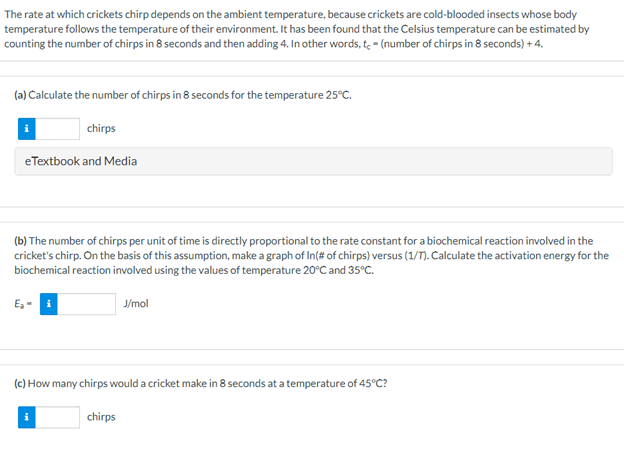The rate at which crickets chirp depends on the ambient temperature, because crickets are cold-blooded insects whose body temperature follows the temperature of their environment. It has been found that the Celsius temperature can be estimated by counting the number of chirps in 8 seconds and then adding 4. In other words, te - (number of chirps in 8 seconds) + 4. (a) Calculate the number of chirps in 8 seconds for the temperature 25°C. chirps eTextbook and Media (b) The number of chirps per unit of time is directly proportional to the rate constant for a biochemical reaction involved in the cricket's chirp. On the basis of this assumption, make a graph of In(# of chirps) versus (1/7). Calculate the activation energy for the biochemical reaction involved using the values of temperature 20°C and 35°C. E, - i J/mol (c) How many chirps would a cricket make in 8 seconds at a temperature of 45°C? chirps
The rate at which crickets chirp depends on the ambient temperature, because crickets are cold-blooded insects whose body temperature follows the temperature of their environment. It has been found that the Celsius temperature can be estimated by counting the number of chirps in 8 seconds and then adding 4. In other words, te - (number of chirps in 8 seconds) + 4. (a) Calculate the number of chirps in 8 seconds for the temperature 25°C. chirps eTextbook and Media (b) The number of chirps per unit of time is directly proportional to the rate constant for a biochemical reaction involved in the cricket's chirp. On the basis of this assumption, make a graph of In(# of chirps) versus (1/7). Calculate the activation energy for the biochemical reaction involved using the values of temperature 20°C and 35°C. E, - i J/mol (c) How many chirps would a cricket make in 8 seconds at a temperature of 45°C? chirps
Chemistry for Engineering Students
4th Edition
ISBN:9781337398909
Author:Lawrence S. Brown, Tom Holme
Publisher:Lawrence S. Brown, Tom Holme
Chapter11: Chemical Kinetics
Section: Chapter Questions
Problem 11.42PAE: Amoxicillin is an antibiotic packaged as a powder. When it is used to treat babies and small...
Related questions
Question

Transcribed Image Text:The rate at which crickets chirp depends on the ambient temperature, because crickets are cold-blooded insects whose body
temperature follows the temperature of their environment. It has been found that the Celsius temperature can be estimated by
counting the number of chirps in 8 seconds and then adding 4. In other words, te - (number of chirps in 8 seconds) + 4.
(a) Calculate the number of chirps in 8 seconds for the temperature 25°C.
chirps
eTextbook and Media
(b) The number of chirps per unit of time is directly proportional to the rate constant for a biochemical reaction involved in the
cricket's chirp. On the basis of this assumption, make a graph of In(# of chirps) versus (1/7). Calculate the activation energy for the
biochemical reaction involved using the values of temperature 20°C and 35°C.
E, - i
J/mol
(c) How many chirps would a cricket make in 8 seconds at a temperature of 45°C?
chirps
Expert Solution
This question has been solved!
Explore an expertly crafted, step-by-step solution for a thorough understanding of key concepts.
Step by step
Solved in 3 steps with 3 images

Knowledge Booster
Learn more about
Need a deep-dive on the concept behind this application? Look no further. Learn more about this topic, chemistry and related others by exploring similar questions and additional content below.Recommended textbooks for you

Chemistry for Engineering Students
Chemistry
ISBN:
9781337398909
Author:
Lawrence S. Brown, Tom Holme
Publisher:
Cengage Learning

Chemical Principles in the Laboratory
Chemistry
ISBN:
9781305264434
Author:
Emil Slowinski, Wayne C. Wolsey, Robert Rossi
Publisher:
Brooks Cole

General Chemistry - Standalone book (MindTap Cour…
Chemistry
ISBN:
9781305580343
Author:
Steven D. Gammon, Ebbing, Darrell Ebbing, Steven D., Darrell; Gammon, Darrell Ebbing; Steven D. Gammon, Darrell D.; Gammon, Ebbing; Steven D. Gammon; Darrell
Publisher:
Cengage Learning

Chemistry for Engineering Students
Chemistry
ISBN:
9781337398909
Author:
Lawrence S. Brown, Tom Holme
Publisher:
Cengage Learning

Chemical Principles in the Laboratory
Chemistry
ISBN:
9781305264434
Author:
Emil Slowinski, Wayne C. Wolsey, Robert Rossi
Publisher:
Brooks Cole

General Chemistry - Standalone book (MindTap Cour…
Chemistry
ISBN:
9781305580343
Author:
Steven D. Gammon, Ebbing, Darrell Ebbing, Steven D., Darrell; Gammon, Darrell Ebbing; Steven D. Gammon, Darrell D.; Gammon, Ebbing; Steven D. Gammon; Darrell
Publisher:
Cengage Learning

Chemistry for Today: General, Organic, and Bioche…
Chemistry
ISBN:
9781305960060
Author:
Spencer L. Seager, Michael R. Slabaugh, Maren S. Hansen
Publisher:
Cengage Learning


Chemistry: Principles and Reactions
Chemistry
ISBN:
9781305079373
Author:
William L. Masterton, Cecile N. Hurley
Publisher:
Cengage Learning